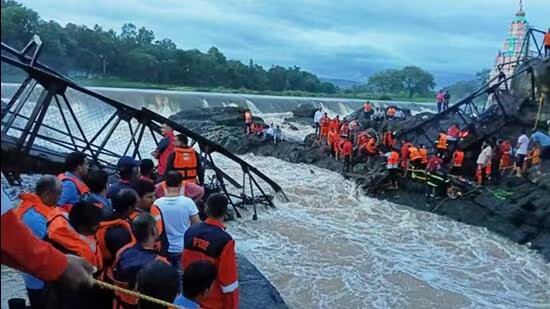
Road
Over the past five years, India has witnessed a disturbing pattern of infrastructure failures, with 55 instances of collapse or damage reported on roads, bridges, and tunnels under the National Highways Authority of India (NHAI). Union Minister for Road Transport and Highways, Nitin Gadkari, disclosed this information in Parliament, raising urgent questions about construction quality, safety audits, and the long-term durability of critical national infrastructure.
These revelations come at a time when India is aggressively expanding its road and highway network to support economic growth, enhance connectivity, and improve logistics. However, the recurring damage and collapse of structures constructed or maintained by NHAI cast a shadow over the country’s infrastructure boom. While rapid development remains a national priority, safety and sustainability cannot be sacrificed.
A Grim Snapshot
According to Gadkari, between 2018 and 2023, NHAI recorded 55 incidents of structural failure involving roads, bridges, and tunnels. These cases were spread across several states and varied in scale—from minor cracks and subsidence to full-blown collapses. Notably, these incidents were not limited to aging infrastructure but included newly constructed structures as well.
This revelation was made in response to a question raised in the Lok Sabha, reflecting the growing concern among lawmakers and citizens alike regarding road safety. Some incidents even resulted in tragic loss of lives and significant property damage, highlighting the gravity of the issue.
Common Causes Identified
While each case has its own context and findings, some recurring causes have been identified:
- Poor Design and Engineering Flaws: In several cases, it was found that the design calculations did not account adequately for load stress, water flow, or soil behavior. Design shortcuts to cut costs have also been blamed.
- Substandard Construction Material: Inadequate quality control during construction often results in premature wear and eventual collapse. Use of substandard cement, steel, and improper layering of roads has surfaced in multiple audits.
- Lack of Maintenance and Monitoring: Many of the damaged structures were not periodically inspected. The absence of a robust monitoring system has allowed minor issues to escalate into catastrophic failures.
- Natural Disasters and Climate Effects: Landslides, floods, and seismic activity have also played a role in some cases. However, many experts argue that proper engineering can minimize such risks.
- Contractor Negligence: Faulty execution by private contractors has been cited in many collapse incidents, with a few firms repeatedly flagged for malpractice.
Government’s Response and Accountability
In his statement, Gadkari assured that NHAI has taken corrective measures in each instance, including blacklisting defaulting contractors, ordering independent safety audits, and redesigning flawed projects. Moreover, NHAI has introduced an automated system for road asset management that aims to identify cracks and vulnerabilities early.
Additionally, the Ministry of Road Transport and Highways is reportedly working to strengthen norms related to quality assurance, third-party inspection, and mandatory auditing of infrastructure during and after construction. The aim is to shift from a reactive to a proactive approach.
Public Confidence and Future Implications
The high number of incidents over just five years has triggered a serious debate about public safety, accountability, and the pace at which infrastructure projects are being rolled out. Experts warn that while India must keep up with infrastructure demands, shortcuts in construction and oversight can lead to fatal outcomes.
Urban planners and civil engineers are urging a rethink of how contracts are awarded and managed. There is also a push for adopting advanced technologies like real-time structural health monitoring systems using IoT and AI to prevent collapses before they occur.
Furthermore, the public perception of NHAI projects has taken a hit. Citizens are increasingly skeptical about traveling on newly built roads and bridges, especially in regions prone to extreme weather. Ensuring the credibility of national infrastructure is crucial not just for mobility but also for economic confidence.
Conclusion
The disclosure of 55 instances of damage or collapse on NHAI projects in just five years is a wake-up call. It is a stark reminder that rapid development without rigorous quality control can have dangerous consequences. The government must now focus on reinforcing structural safety, enforcing strict penalties for negligence, and building public trust through transparency and accountability.
As India pushes forward with its ambitious infrastructure agenda, ensuring that every road, bridge, and tunnel is not just built fast—but built to last—must become a national priority.
Thanks For Reading